Information Systems Assignment: Controls, Models, and Business Value
VerifiedAdded on 2022/11/26
|5
|1209
|497
Homework Assignment
AI Summary
This document presents a comprehensive solution to an Information Systems assignment. It addresses key concepts such as information system controls, defining them and providing examples of their organizational application. The assignment further explores the value added by enterprise syste...
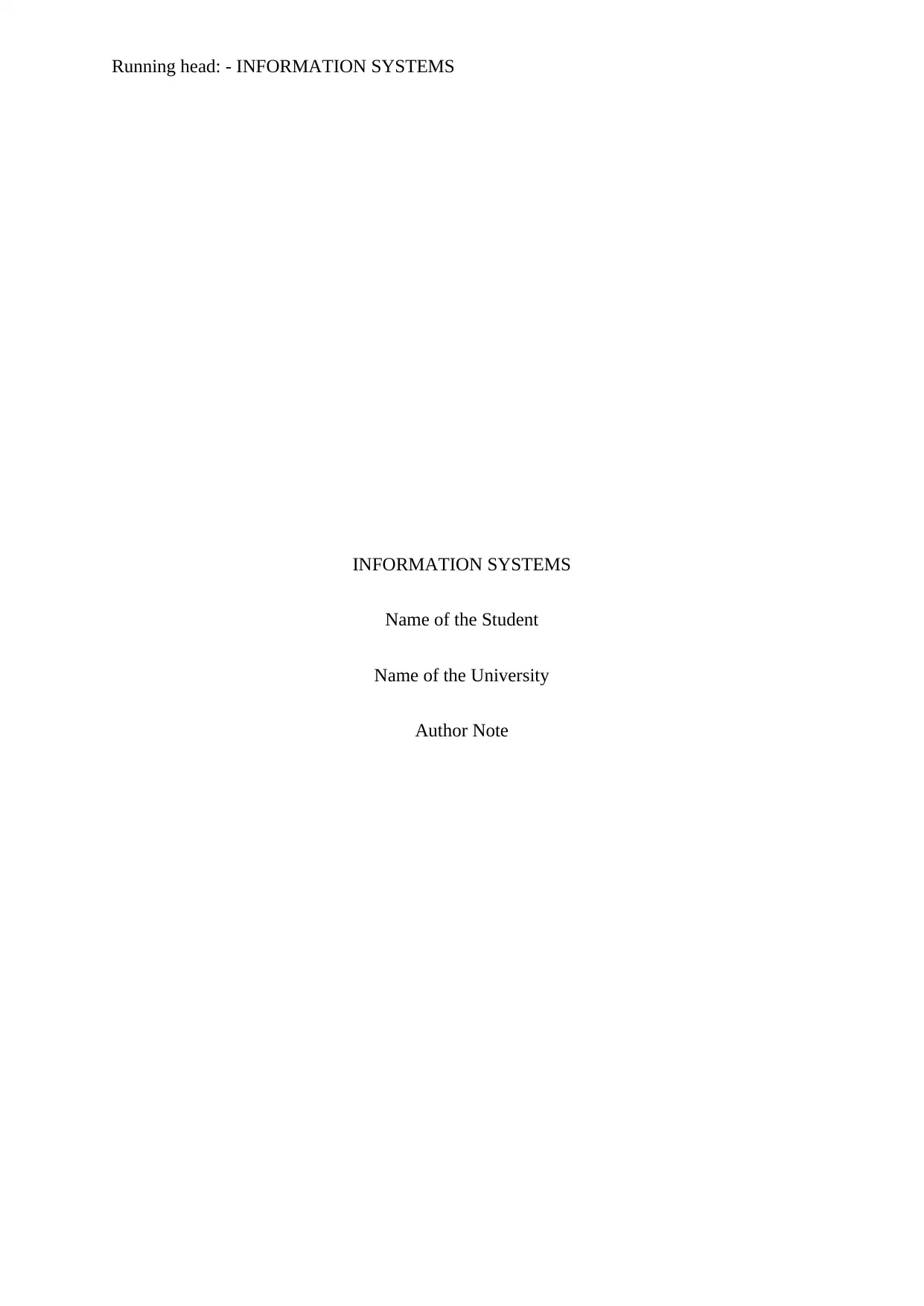
Running head: - INFORMATION SYSTEMS
INFORMATION SYSTEMS
Name of the Student
Name of the University
Author Note
INFORMATION SYSTEMS
Name of the Student
Name of the University
Author Note
Paraphrase This Document
Need a fresh take? Get an instant paraphrase of this document with our AI Paraphraser
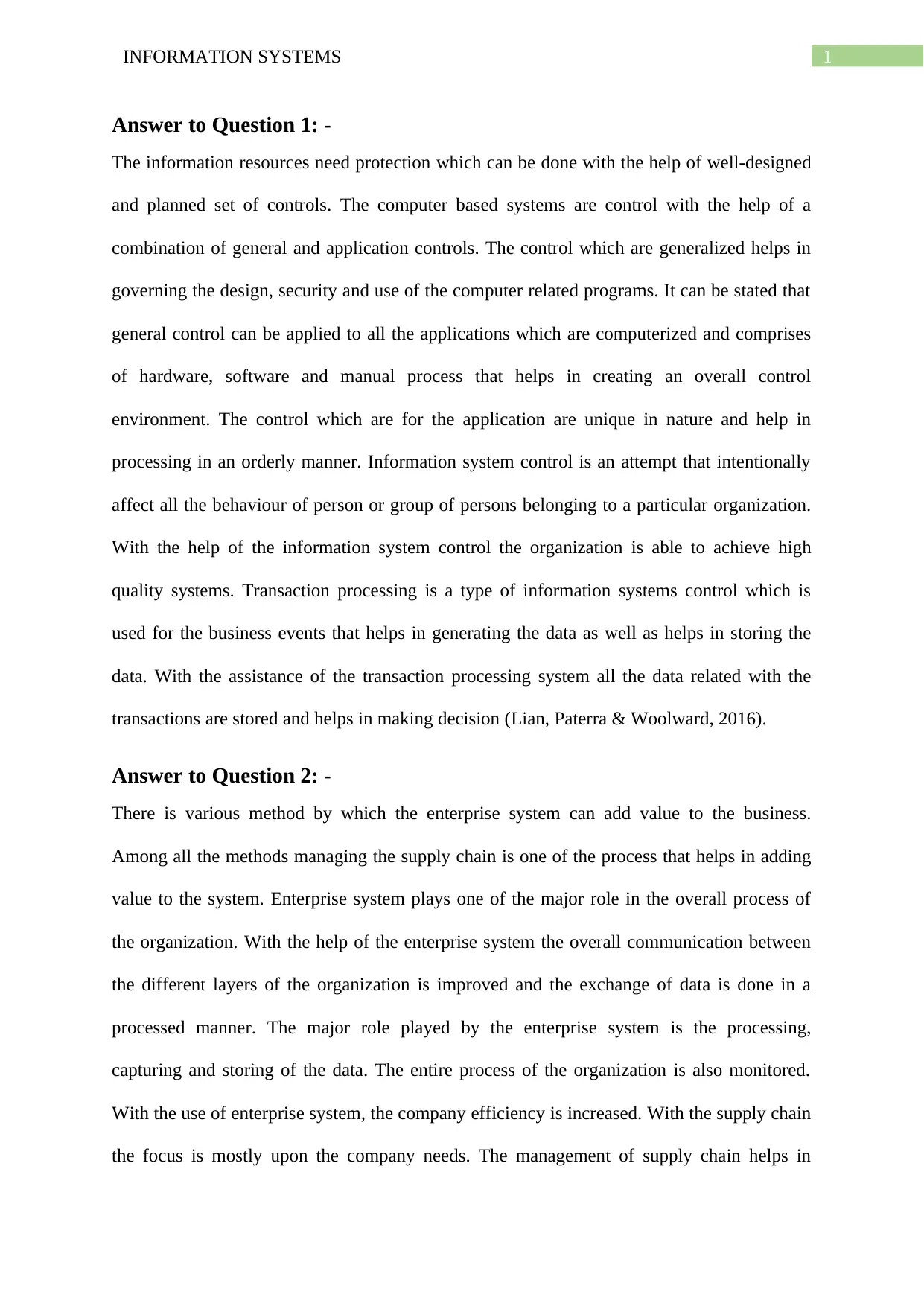
1INFORMATION SYSTEMS
Answer to Question 1: -
The information resources need protection which can be done with the help of well-designed
and planned set of controls. The computer based systems are control with the help of a
combination of general and application controls. The control which are generalized helps in
governing the design, security and use of the computer related programs. It can be stated that
general control can be applied to all the applications which are computerized and comprises
of hardware, software and manual process that helps in creating an overall control
environment. The control which are for the application are unique in nature and help in
processing in an orderly manner. Information system control is an attempt that intentionally
affect all the behaviour of person or group of persons belonging to a particular organization.
With the help of the information system control the organization is able to achieve high
quality systems. Transaction processing is a type of information systems control which is
used for the business events that helps in generating the data as well as helps in storing the
data. With the assistance of the transaction processing system all the data related with the
transactions are stored and helps in making decision (Lian, Paterra & Woolward, 2016).
Answer to Question 2: -
There is various method by which the enterprise system can add value to the business.
Among all the methods managing the supply chain is one of the process that helps in adding
value to the system. Enterprise system plays one of the major role in the overall process of
the organization. With the help of the enterprise system the overall communication between
the different layers of the organization is improved and the exchange of data is done in a
processed manner. The major role played by the enterprise system is the processing,
capturing and storing of the data. The entire process of the organization is also monitored.
With the use of enterprise system, the company efficiency is increased. With the supply chain
the focus is mostly upon the company needs. The management of supply chain helps in
Answer to Question 1: -
The information resources need protection which can be done with the help of well-designed
and planned set of controls. The computer based systems are control with the help of a
combination of general and application controls. The control which are generalized helps in
governing the design, security and use of the computer related programs. It can be stated that
general control can be applied to all the applications which are computerized and comprises
of hardware, software and manual process that helps in creating an overall control
environment. The control which are for the application are unique in nature and help in
processing in an orderly manner. Information system control is an attempt that intentionally
affect all the behaviour of person or group of persons belonging to a particular organization.
With the help of the information system control the organization is able to achieve high
quality systems. Transaction processing is a type of information systems control which is
used for the business events that helps in generating the data as well as helps in storing the
data. With the assistance of the transaction processing system all the data related with the
transactions are stored and helps in making decision (Lian, Paterra & Woolward, 2016).
Answer to Question 2: -
There is various method by which the enterprise system can add value to the business.
Among all the methods managing the supply chain is one of the process that helps in adding
value to the system. Enterprise system plays one of the major role in the overall process of
the organization. With the help of the enterprise system the overall communication between
the different layers of the organization is improved and the exchange of data is done in a
processed manner. The major role played by the enterprise system is the processing,
capturing and storing of the data. The entire process of the organization is also monitored.
With the use of enterprise system, the company efficiency is increased. With the supply chain
the focus is mostly upon the company needs. The management of supply chain helps in
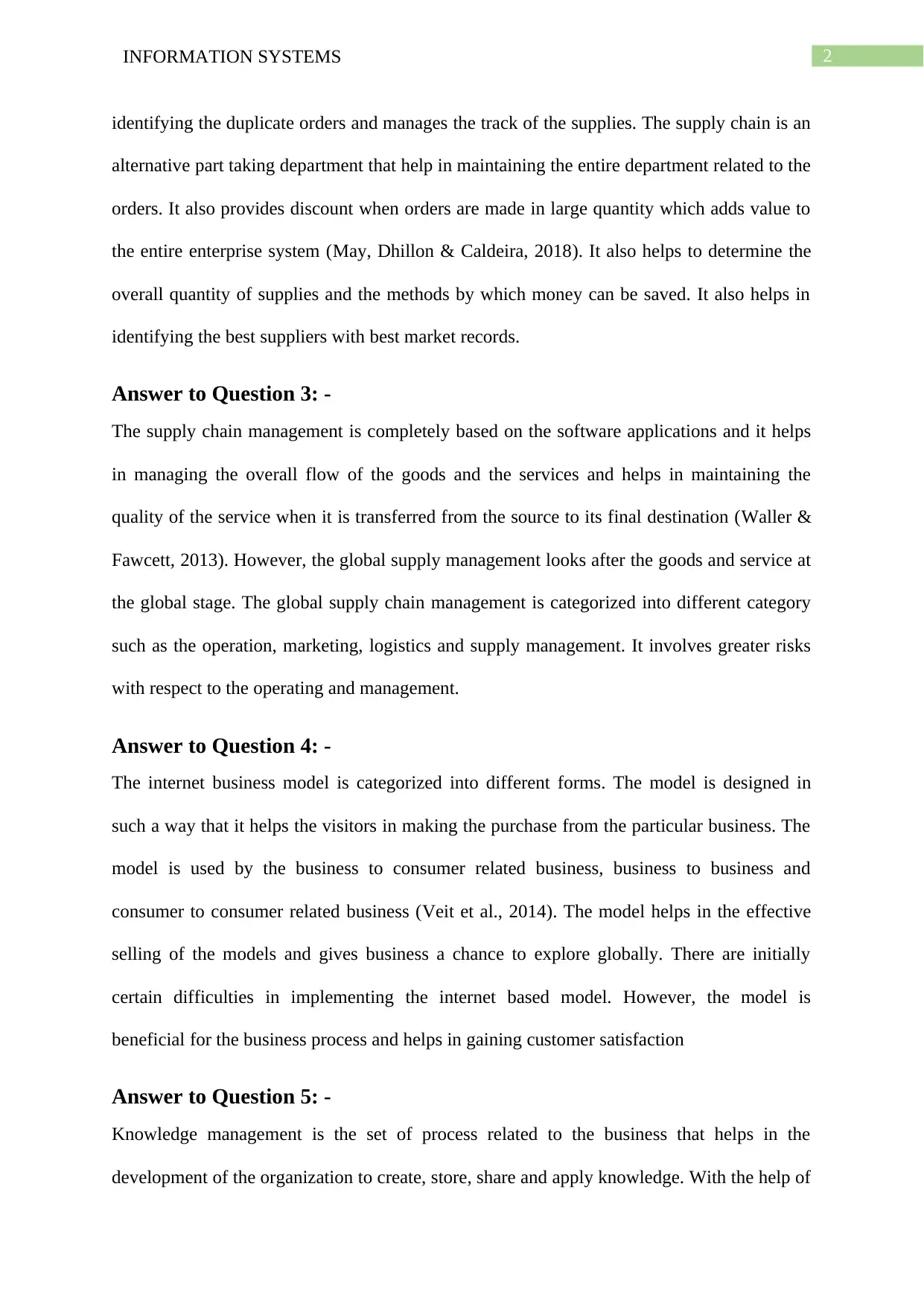
2INFORMATION SYSTEMS
identifying the duplicate orders and manages the track of the supplies. The supply chain is an
alternative part taking department that help in maintaining the entire department related to the
orders. It also provides discount when orders are made in large quantity which adds value to
the entire enterprise system (May, Dhillon & Caldeira, 2018). It also helps to determine the
overall quantity of supplies and the methods by which money can be saved. It also helps in
identifying the best suppliers with best market records.
Answer to Question 3: -
The supply chain management is completely based on the software applications and it helps
in managing the overall flow of the goods and the services and helps in maintaining the
quality of the service when it is transferred from the source to its final destination (Waller &
Fawcett, 2013). However, the global supply management looks after the goods and service at
the global stage. The global supply chain management is categorized into different category
such as the operation, marketing, logistics and supply management. It involves greater risks
with respect to the operating and management.
Answer to Question 4: -
The internet business model is categorized into different forms. The model is designed in
such a way that it helps the visitors in making the purchase from the particular business. The
model is used by the business to consumer related business, business to business and
consumer to consumer related business (Veit et al., 2014). The model helps in the effective
selling of the models and gives business a chance to explore globally. There are initially
certain difficulties in implementing the internet based model. However, the model is
beneficial for the business process and helps in gaining customer satisfaction
Answer to Question 5: -
Knowledge management is the set of process related to the business that helps in the
development of the organization to create, store, share and apply knowledge. With the help of
identifying the duplicate orders and manages the track of the supplies. The supply chain is an
alternative part taking department that help in maintaining the entire department related to the
orders. It also provides discount when orders are made in large quantity which adds value to
the entire enterprise system (May, Dhillon & Caldeira, 2018). It also helps to determine the
overall quantity of supplies and the methods by which money can be saved. It also helps in
identifying the best suppliers with best market records.
Answer to Question 3: -
The supply chain management is completely based on the software applications and it helps
in managing the overall flow of the goods and the services and helps in maintaining the
quality of the service when it is transferred from the source to its final destination (Waller &
Fawcett, 2013). However, the global supply management looks after the goods and service at
the global stage. The global supply chain management is categorized into different category
such as the operation, marketing, logistics and supply management. It involves greater risks
with respect to the operating and management.
Answer to Question 4: -
The internet business model is categorized into different forms. The model is designed in
such a way that it helps the visitors in making the purchase from the particular business. The
model is used by the business to consumer related business, business to business and
consumer to consumer related business (Veit et al., 2014). The model helps in the effective
selling of the models and gives business a chance to explore globally. There are initially
certain difficulties in implementing the internet based model. However, the model is
beneficial for the business process and helps in gaining customer satisfaction
Answer to Question 5: -
Knowledge management is the set of process related to the business that helps in the
development of the organization to create, store, share and apply knowledge. With the help of
⊘ This is a preview!⊘
Do you want full access?
Subscribe today to unlock all pages.

Trusted by 1+ million students worldwide
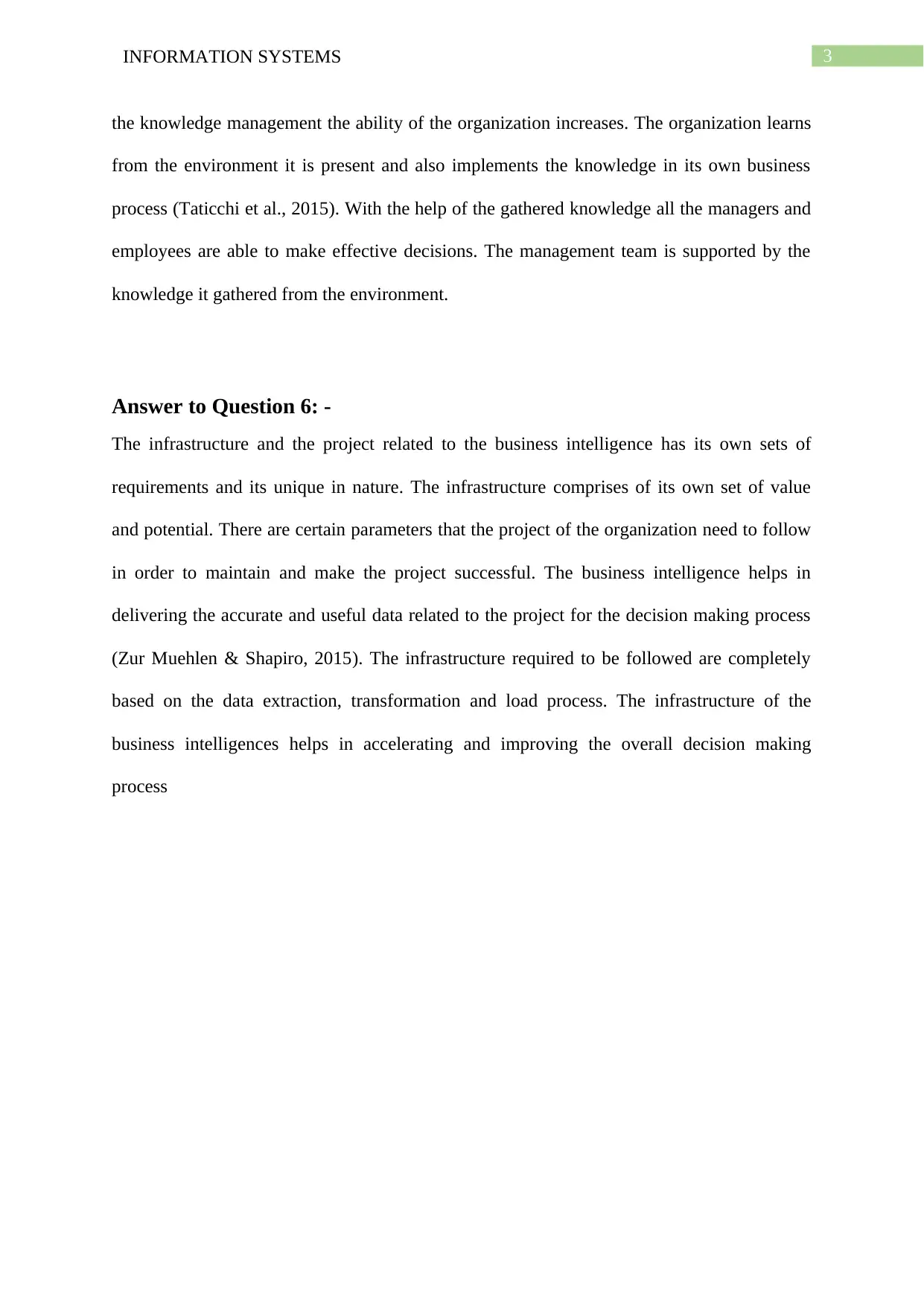
3INFORMATION SYSTEMS
the knowledge management the ability of the organization increases. The organization learns
from the environment it is present and also implements the knowledge in its own business
process (Taticchi et al., 2015). With the help of the gathered knowledge all the managers and
employees are able to make effective decisions. The management team is supported by the
knowledge it gathered from the environment.
Answer to Question 6: -
The infrastructure and the project related to the business intelligence has its own sets of
requirements and its unique in nature. The infrastructure comprises of its own set of value
and potential. There are certain parameters that the project of the organization need to follow
in order to maintain and make the project successful. The business intelligence helps in
delivering the accurate and useful data related to the project for the decision making process
(Zur Muehlen & Shapiro, 2015). The infrastructure required to be followed are completely
based on the data extraction, transformation and load process. The infrastructure of the
business intelligences helps in accelerating and improving the overall decision making
process
the knowledge management the ability of the organization increases. The organization learns
from the environment it is present and also implements the knowledge in its own business
process (Taticchi et al., 2015). With the help of the gathered knowledge all the managers and
employees are able to make effective decisions. The management team is supported by the
knowledge it gathered from the environment.
Answer to Question 6: -
The infrastructure and the project related to the business intelligence has its own sets of
requirements and its unique in nature. The infrastructure comprises of its own set of value
and potential. There are certain parameters that the project of the organization need to follow
in order to maintain and make the project successful. The business intelligence helps in
delivering the accurate and useful data related to the project for the decision making process
(Zur Muehlen & Shapiro, 2015). The infrastructure required to be followed are completely
based on the data extraction, transformation and load process. The infrastructure of the
business intelligences helps in accelerating and improving the overall decision making
process
Paraphrase This Document
Need a fresh take? Get an instant paraphrase of this document with our AI Paraphraser
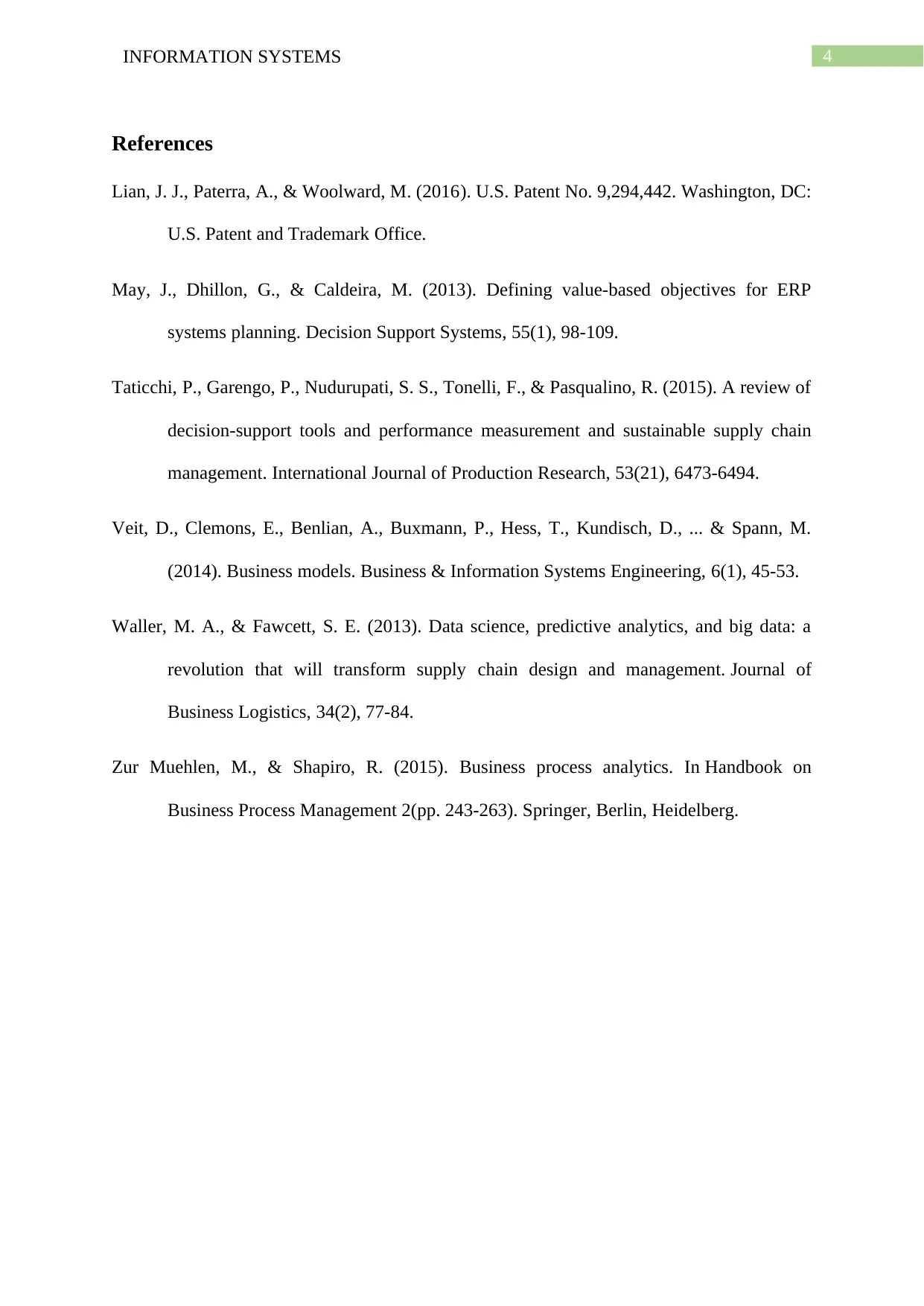
4INFORMATION SYSTEMS
References
Lian, J. J., Paterra, A., & Woolward, M. (2016). U.S. Patent No. 9,294,442. Washington, DC:
U.S. Patent and Trademark Office.
May, J., Dhillon, G., & Caldeira, M. (2013). Defining value-based objectives for ERP
systems planning. Decision Support Systems, 55(1), 98-109.
Taticchi, P., Garengo, P., Nudurupati, S. S., Tonelli, F., & Pasqualino, R. (2015). A review of
decision-support tools and performance measurement and sustainable supply chain
management. International Journal of Production Research, 53(21), 6473-6494.
Veit, D., Clemons, E., Benlian, A., Buxmann, P., Hess, T., Kundisch, D., ... & Spann, M.
(2014). Business models. Business & Information Systems Engineering, 6(1), 45-53.
Waller, M. A., & Fawcett, S. E. (2013). Data science, predictive analytics, and big data: a
revolution that will transform supply chain design and management. Journal of
Business Logistics, 34(2), 77-84.
Zur Muehlen, M., & Shapiro, R. (2015). Business process analytics. In Handbook on
Business Process Management 2(pp. 243-263). Springer, Berlin, Heidelberg.
References
Lian, J. J., Paterra, A., & Woolward, M. (2016). U.S. Patent No. 9,294,442. Washington, DC:
U.S. Patent and Trademark Office.
May, J., Dhillon, G., & Caldeira, M. (2013). Defining value-based objectives for ERP
systems planning. Decision Support Systems, 55(1), 98-109.
Taticchi, P., Garengo, P., Nudurupati, S. S., Tonelli, F., & Pasqualino, R. (2015). A review of
decision-support tools and performance measurement and sustainable supply chain
management. International Journal of Production Research, 53(21), 6473-6494.
Veit, D., Clemons, E., Benlian, A., Buxmann, P., Hess, T., Kundisch, D., ... & Spann, M.
(2014). Business models. Business & Information Systems Engineering, 6(1), 45-53.
Waller, M. A., & Fawcett, S. E. (2013). Data science, predictive analytics, and big data: a
revolution that will transform supply chain design and management. Journal of
Business Logistics, 34(2), 77-84.
Zur Muehlen, M., & Shapiro, R. (2015). Business process analytics. In Handbook on
Business Process Management 2(pp. 243-263). Springer, Berlin, Heidelberg.
1 out of 5
Related Documents
Your All-in-One AI-Powered Toolkit for Academic Success.
+13062052269
info@desklib.com
Available 24*7 on WhatsApp / Email
![[object Object]](/_next/static/media/star-bottom.7253800d.svg)
Unlock your academic potential
© 2024 | Zucol Services PVT LTD | All rights reserved.




